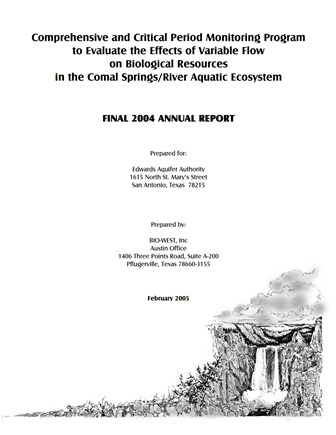Comprehensive and Critical Period Monitoring Program to Evaluate the Effects of Variable Flow on Biological Resources in the Comal Springs/River Aquatic Ecosystem Final 2004 Annual Report

| Summary |
|
The purpose of this report is to document the results of all aquatic ecosystem monitoring conducted in 2004 at Comal Springs located in New Braunfels, Texas. The monitoring and report preparation was performed by BIO-WEST, Inc. Pflugerville, Texas. [Excerpted from the Executive Summary] Overall water quality was assessed quarterly throughout the entire Comal River during 2000-2002 using standard parameters (water temperature, dissolved oxygen, pH, and conductivity) as well as conventional water chemistry parameters (nitrate, total nitrogen, ammonia, soluble reactive phosphorus, total phosphorus, alkalinity, and total suspended solids)…. This assessment suggested that all water quality parameters had relatively narrow ranges that were providing high quality conditions for aquatic life use. … For the fountain darter, habitat use is largely influenced by aquatic vegetation and assessments of habitat availability were conducted by mapping this vegetation during each sampling event. Throughout the study, aquatic vegetation remained abundant in most reaches despite the frequent scouring associated with flooding…. The most highly affected plant types tended to be the vegetation types that support the highest densities of fountain darter…. These results indicate the strong influence of bryophytes on the total population of fountain darters in the Comal Springs/River ecosystem. … Drop net data also provided information on the overall size-class distribution for the Comal Springs/River ecosystem, which continues to indicate a healthy fish assemblage. In addition, species diversity was calculated for the entire fish community in each reach during each sample effort in 2000-2004. Though there were some differences in natural diversity among reaches, there were no discernable patterns of change in diversity at the reach level during 2000-2004. … By all indications the density of giant ramshorn snails observed in the Comal ecosystem during the study period to date (including the 2000 low-flow events) pose no serious threat to the aquatic vegetative community (i.e., fountain darter habitat). However, because of the impact that this exotic species can have under heavier densities, close monitoring of this species should continue. … Gill parasites varied substantially in abundance among sample sites during this study, but variation among seasons was less pronounced….[M]ore studies are needed to evaluate the relationships between snails and abundance of parasites. … Observations of Comal Springs salamander have varied in number within and between locations during 2000-2004, but individuals have been observed in each sample location during each sample period. There was no distinct pattern of variation in salamander abundance with changes in discharge; however, there was a trend of increasing numbers of salamanders surveyed in the eastern outfall adjacent Spring Island in 2003 and 2004. … [T]here was a distinct influence of high-flows on the 2004 samples. However, despite the differences in springflow conditions relative to 2003, many of the findings in 2004 were very similar to those in 2003. … The new sample method for Comal Springs riffle beetles, adopted in 2004, provided a larger sample size which improved the ability to evaluate potential differences in population abundance among sites, seasons and with different depths and flows. Previous sampling indicated that there were differences in population size among the three sample areas, but there were similar numbers of Comal Springs riffle beetles (adults and larvae) observed in all sites in 2004. There were also data to suggest that the species has precise requirements (e.g., physical characteristics or food source) that govern its distribution. … This study remains the most comprehensive biological evaluation that has ever been conducted on the Comal River ecosystem. |
Search for Documents
Advance Search
Explore EAA's Scientific Reports
- All Reports
- Modeling
- Hydrology and Hydrogeology
- History
- Groundwater Recharge, Recharge Zone
- Groundwater Movement
- Geomorphology and Caves
- Weather Modification
- Geology
- Water Use and Conservation
- Geochemistry
- Water Resources Planning and Management
- Floods and Drought
- Water Quality
- Climatology
- Surface Water / Groundwater Relationship
- Biology
- Springs, Groundwater Discharge
- Archaeology
- RZ Protection
- Aquifer Levels
- Remote Sensing
- Precipitation
- Overview Studies
